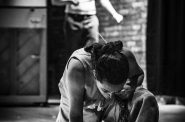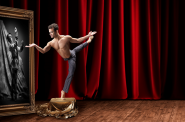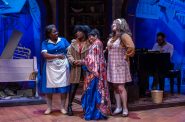Five things I’ve been meaning to tell you (12/22)
On Dec. 11, I saw and reviewed the Milwaukee Ballet‘s The Nutcracker, with Valerie Harmon and David Hovhannisyan as Marie and Karl, the big, romantic dancing roles. I revisited The Nutcracker, by Michael Pink, on Dec. 21 and saw a very different show with Yuki Clark and Alexandre Ferreira in those roles. Harmon and Hovhannisyan’s athletic exuberance contrasts sharply with Clark and Ferreira’s exquisite delicacy. The first couple bowls you over; the second couple draws you in. I loved Harmon and Hovhannisyan and Clark and Ferreira equally, but in different ways. I’m very glad to have gone back and would recommend a second visit to see another cast. The differences are illuminating
I am happy to report that 11 days into the run, the entire company has maintained its bright energy. Pink has allowed his rotating casts a measure of creativity, especially with the comic business. The apparent result is that they’re having fun with the show rather than growing weary of it, so we have fun, too. That includes the Milwaukee Ballet Orchestra, which under Pasquale Laurino is playing as if it just loves doing Tchaikovsky over and over.
More Milwaukee Ballet: The Harmony Initiative, a joint effort with the Medical College of Wisconsin and the UWM Peck School of the Arts, continues to progress. The initiative, announced in 2009, would put the Milwaukee Ballet in a new home Downtown. The partners have settled on a site, the one now occupied by the Marcus Center’s crumbling parking structure, just north across State Street from Uihlein Hall. Last week, the Milwaukee County board voted to pursue the redevelopment of the site with the Harmony Initiative. The partners have filed papers for a new, non-profit Harmony entity to run the facility as an independent entity.
“We still have a way to go, but we are expanding and deepening our relationships,” Buehler said. “Now we have to sit down and discuss methods.”
The facility would include a parking structure, studios and offices for the ballet and its school, a theater in the 300-seat range, all shared in some way with UWM, and a sports medicine facility.
More Peck School of the Arts: We don’t usually review student shows, but I caught the UWM Theater Department’s staging of Shakepeare’s As You Like It on Dec. 8, the Dance Department’s New Dancemakers undergrad choreography show on Dec. 9 and the Department of Art and Design BFA show on Dec 16.
The students showed very high levels of craft in all three shows. The artists handled materials expertly. The dancers’ technique and athleticism impressed. The young actors needed about 10 minutes to hit their stride, in terms of pacing and scale, but once they did they made Shakespeare natural and laugh-out-loud funny.
But I have a note for the choreographers: Lighten up. Just one in 13 over two programs showed a sense of humor. Way too much post-adolescent angst for one night. Choreographers, try to keep this in mind the next time around: Art is not about expressing yourself. Art is about making something that might engage someone who isn’t you.
Paul Goldberger spoke at the Milwaukee Art Museum Nov. 30, in conjunction with MAM’s celebration of Santiago Calatrava’s annex to
the museum. Goldberger, a celebrated writer on the subject of architecture, turned out to be a witty and illuminating speaker, as well. This was not his first visit to the building; Goldberger, formerly of the New York Times and currently of the New Yorker magazine, wrote about the new wing 10 years ago and seems to have given it considerable thought since.
He spoke with great insight and no condescension about the building’s iconic status for the city: “Milwaukee is small enough that a single building can stand for the aspirations of a city.”
Goldberger pointed out that our museum is part of a trend throughout the Western world of museum buildings taking on larger roles as civic symbols.
“Museums have become cities’ calling cards,” he said. “Once, it was the cathedral. Museums are now unique and conspicuous, not just containers of art, but artworks themselves.”
Goldberger, a Pulitzer Prize winner, is very well known, but his fascinating talk did not even half-fill the museum’s auditorium. Many of these museum talks are very good and deserve a larger audience. So take one in when you can; you can keep track of them here.
Finally, I want to share a little Christmas gift with you: We’ve become friendly with Cathy and Mario Costantini, owners of the La Lune Collection line of furniture. Mario is the force behind the Mad Hot Ballroom idea, which caught fire in Milwaukee when Danceworks ran with it. I knew Mario a little through the Danceworks connection, and have come to know him better since we moved to Weil Street, just up the block from La Lune’s factory and offices. A few minutes ago, the doorbell rang and a La Lune employee dropped off a holiday gift, the Mad Hot and bold Blend from Alterra Coffee (another business neighbor, two blocks away at Chambers and Humboldt.) Thanks, Cathy and Mario. You two do everything in high style.
Art
-
Winning Artists Works on Display
 May 30th, 2024 by Annie Raab
May 30th, 2024 by Annie Raab
-
5 Huge Rainbow Arcs Coming To Downtown
 Apr 29th, 2024 by Jeramey Jannene
Apr 29th, 2024 by Jeramey Jannene
-
Exhibit Tells Story of Vietnam War Resistors in the Military
 Mar 29th, 2024 by Bill Christofferson
Mar 29th, 2024 by Bill Christofferson
Dance
-
New Riverwest Company, Production Impresses
 Feb 10th, 2020 by Brendan Fox
Feb 10th, 2020 by Brendan Fox
-
Milwaukee Ballet Show Remakes History
 Feb 10th, 2020 by Catherine Jozwik
Feb 10th, 2020 by Catherine Jozwik
-
Ballet Does Free Production of ‘Nutcracker’
 Dec 20th, 2019 by Richard Davis
Dec 20th, 2019 by Richard Davis
Theater
-
‘The Treasurer’ a Darkly Funny Family Play
 Apr 29th, 2024 by Dominique Paul Noth
Apr 29th, 2024 by Dominique Paul Noth
-
Rep’s Nina Simone Play a Puzzle
 Apr 23rd, 2024 by Dominique Paul Noth
Apr 23rd, 2024 by Dominique Paul Noth
-
Skylight’s ‘Eternity’ Is a Slam Bang Show
 Apr 15th, 2024 by Dominique Paul Noth
Apr 15th, 2024 by Dominique Paul Noth



























Tom, thanks for coming to see both New Dancemakers shows and taking the time for a mention. It is always so appreciated. As this year’s artistic director, I understand your perspective on the tone of the majority of the works (actually there were 2 “funnier” dances but one was a very “under” Yvonne Rainer-esque moment of quirk–a kind of very bad non-dynamic Christmas party). However, I think that in an educational setting, our main push is for the younger folks to find their voices apart from obligation to necessarily entertain or connect (yet). If they don’t get the chance to make work that reflects their experience, there are all too many commercial voices and pressures to please in the realm of entertainment. For many, this is their first opportunity to make any kind of group work and for some, may be the only time. I also think it’s important to ask ourselves why so many of them projected such sad and dystopian world views–their experiences point to them longing to connect but being in a world/family where this isn’t necessarily possible. I find this moving and disconcerting and, as an educator, worthy of exploration. Thanks always for your support!
You are so right about Cathy and Mario Costantini–two shining stars when it comes to caring about our community! We at Danceworks are extremely grateful to both of them.
I really appreciate your support of student work. Most critics don’t. However, I take issue with the point that “post-adolescent angst” is a topic only interesting to the student choreographer him or herself. Perhaps you might take into account the fact that you are not a young person, and that perhaps post-adolescent angst is very interesting to, oh, post-adolescents (whatever you mean by that term). The “this doesn’t engage anyone but you” attitude sounds a lot like “this doesn’t engage ME.” One of the responsibilities of a critic is to be conscious of his or her own subject position. There are other, more convincing criticisms of this program of student dance pieces, though that is a story for another blog comment. On the whole, I applaud the choreographers for addressing difficult issues.
Hi Elizabeth and Dancelover,
Thanks for commenting. Just to put a slightly finer point on my point: The first instinct of every young artist is to bare those feelings inside that they just can’t hide.
I say that the most important lesson an artist (or anyone else, for that matter) can learn in life is, to quote “Casablanca,” “The feelings of two little people don’t amount to a hill of beans in this crazy world.”
The best favor any of us can do for young artists is to break them from reflexive navel-gazing as early as possible in their careers and get them to engage life and art more objectively. They will not lose their distinctive voices; they will just have something bigger to talk about. — Strini